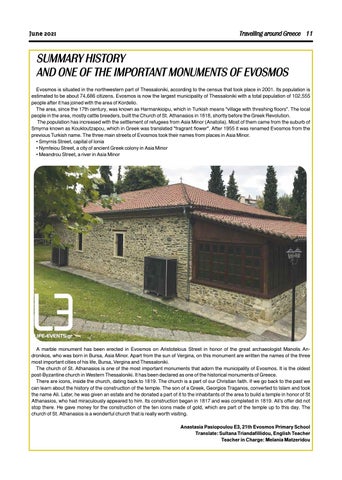June 2021
Travelling around Greece 11
SUMMARY HISTORY AND ONE OF THE IMPORTANT MONUMENTS OF EVOSMOS Evosmos is situated in the northwestern part of Thessaloniki, according to the census that took place in 2001. Its population is estimated to be about 74,686 citizens. Evosmos is now the largest municipality of Thessaloniki with a total population of 102,555 people after it has joined with the area of Kordelio. The area, since the 17th century, was known as Harmankioipu, which in Turkish means "village with threshing floors". The local people in the area, mostly cattle breeders, built the Church of St. Athanasios in 1818, shortly before the Greek Revolution. The population has increased with the settlement of refugees from Asia Minor (Anatolia). Most of them came from the suburb of Smyrna known as Koukloutzapou, which in Greek was translated "fragrant flower". After 1955 it was renamed Evosmos from the previous Turkish name. The three main streets of Evosmos took their names from places in Asia Minor. • Smyrnis Street, capital of Ionia • Nymfeiou Street, a city of ancient Greek colony in Asia Minor • Meandrou Street, a river in Asia Minor
A marble monument has been erected in Evosmos on Aristotelous Street in honor of the great archaeologist Manolis Andronikos, who was born in Bursa, Asia Minor. Apart from the sun of Vergina, on this monument are written the names of the three most important cities of his life, Bursa, Vergina and Thessaloniki. The church of St. Athanasios is one of the most important monuments that adorn the municipality of Evosmos. It is the oldest post-Byzantine church in Western Thessaloniki. It has been declared as one of the historical monuments of Greece. There are icons, inside the church, dating back to 1819. The church is a part of our Christian faith. If we go back to the past we can learn about the history of the construction of the temple. The son of a Greek, Georgios Traganos, converted to Islam and took the name Ali. Later, he was given an estate and he donated a part of it to the inhabitants of the area to build a temple in honor of St Athanasios, who had miraculously appeared to him. Its construction began in 1817 and was completed in 1819. Ali's offer did not stop there. He gave money for the construction of the ten icons made of gold, which are part of the temple up to this day. The church of St. Athanasios is a wonderful church that is really worth visiting. Anastasia Pasiopoulou Ε3, 21th Evosmos Primary School Translate: Sultana Triandafillidou, English Teacher Teacher in Charge: Melania Matzeridou
